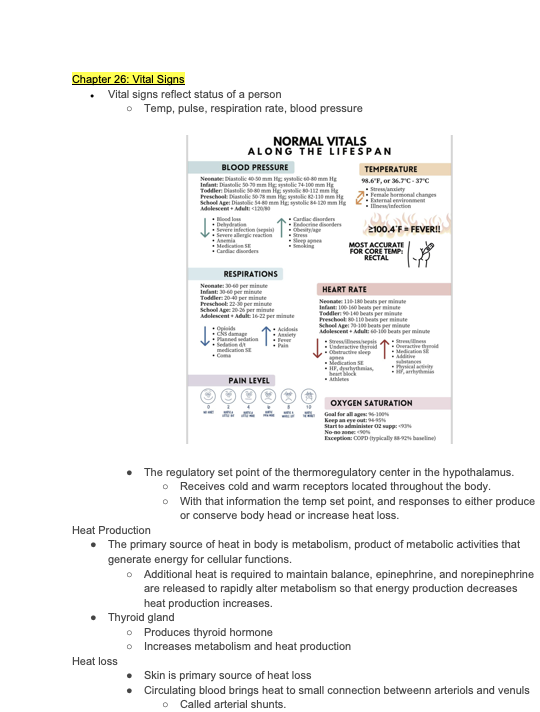Chapter 26: Vital Signs
Chapter 26: Vital Signs
● Vital signs reflect status of a person
○ Temp, pulse, respiration rate, blood pressure
● The regulatory set point of the thermoregulatory center in the hypothalamus.
○ Receives cold and warm receptors located throughout the body.
○ With that information the temp set point, and responses to either produce or conserve body head or increase heat loss.
Heat Production
● The primary source of heat in body is metabolism, product of metabolic activities that generate energy for cellular functions.
○ Additional heat is required to maintain balance, epinephrine, and norepinephrine are released to rapidly alter metabolism so that energy production decreases heat production increases.
● Thyroid gland
○ Produces thyroid hormone
○ Increases metabolism and heat production
Heat loss
● Skin is primary source of heat loss
● Circulating blood brings heat to small connection betweenn arteriols and venuls
○ Called arterial shunts.
■ May open to allow heat to dissipate or may close and retain heat.
○ Sympathetic nervous system controls the opening and closing of the shunts in response to changes in core body temp and environment temp
● Heat is transferred through radiation, convection, evaporation, and conduction.
● Hypothermia-low body temp
● Hyperthermia-high body temp
● Afebrile-without fever
Increased body temperature
❖ Pyrexia (fever)- increase in body temperature
➢ Response to upward displacement of thermoregulatory set point in the hypothalamus, caused by pyrogens (cause fevers).
■ bateria/viruses can make this happen
➢ When thermostatic set point of hypothalamus is increased in response to pyrogen, the hypothalamus initiates temp-rising mechanisms: shivering, piloerections, vasoconstriction, increased metabolism.
❖ Treatment
➢ Bacterial or microbial infection an antibiotic or anti-ineffective may be prescribed.
➢ Antipyretic: aspirin, ibuprofen, or acetaminophen
➢ Cool sponge bath, cool packs, and cooling blankets
Decreased body temp
❖ Hypothermia occurs when compensatory physiologic responses meant to produce and retain heat are overwhelmed by unprotected exposure to cold environment.
➢ May have slurred speech, amnesia, hallucinations, and stupor
➢ Respirations decrease and the pulse becomes weak and irregular with lowering of bp.
Sites of temperature
❖ Most common is sublingual, under the tongue
➢ If patient has eaten hot or cold food or fluids wait 15 to 30 min to return to normal temp.
➢ Should not take oral temp is they have had surgery in nose or mouth or when there is a risk of seizures.
➢ Normal temps : 96.6-99.5
❖ Anal canal for rectal temp (most accurate core temp)
➢ Not used in newborns, children with diarrhea, or patients that have had rectal surgeries.
➢ Due to insertion, thermometer can slow heart rate by stimulating vagus nerve.
❖ Axilla (armpit)
➢ Normal readings: 96.5-98.5
❖ Tympanic (ear)
➢ Not used when patient has drainage, ear pain, ear infection, or scars on tympanic membrane.
➢ Maybe impacted by earwax
❖ Temporal (swiped over the skin covering temporal artery)
➢ If patient is lying on their side, measure only area exposed to environment.
➢ Do not measure over scar tissues, lesions, or abrasions.
Pulse
➔ Peripheral pulse is a throbbing sensation that can be felt over peripheral artery such as radial or carotid artery.
◆ Result from a wave of blood being pumped into the arterial circulation by the contraction of left ventricle.
◆ Heart contracts to eject blood into an already full aorta, smooth muscle in the arteries expands to compensate for increase in pressure of the blood.
◆ Rhythmic distention of the arterial walls is the result of surges of blood as the heart beats.
◆ Ther distention of the arteries move along the arterial system until it reaches the capillaries where vessel walls lack elasticity and peripheral resistance to blood flow
◆ Strength of pulse reflect the amount of blood ejected with each beat of the heart
➔ Apical pulse: listened over the apex of the heart as the heart beats.
◆ Characteried as lub-dub
◆ Mitral and tricusid “lub” and aortic and pulmonic valves “dub”
Physiology of Pulse
● Regulated through autonomic nervous system through snioatrial node of the heart.
● Paraympatheric stimulation of the SA node via the vagus nerve decreased the heart rate, and sympathetic stimulation of the SA node increases the heart rate and force of contraction.
○ Normal rate: 60-100 beats per minute
○ Tachycardia: rapid heart rate
■ Decreases cardiac filling time, decreases stroke volume and cardiac output, leading to decreased tissue perfusion.
○ Bradycardia: rate below 60 beats per min.
■ Can be normal in athletes and during sleep
○ Described amplitude: forceful, weak and thready when it is decreased in quality.
■ bounding=strong
